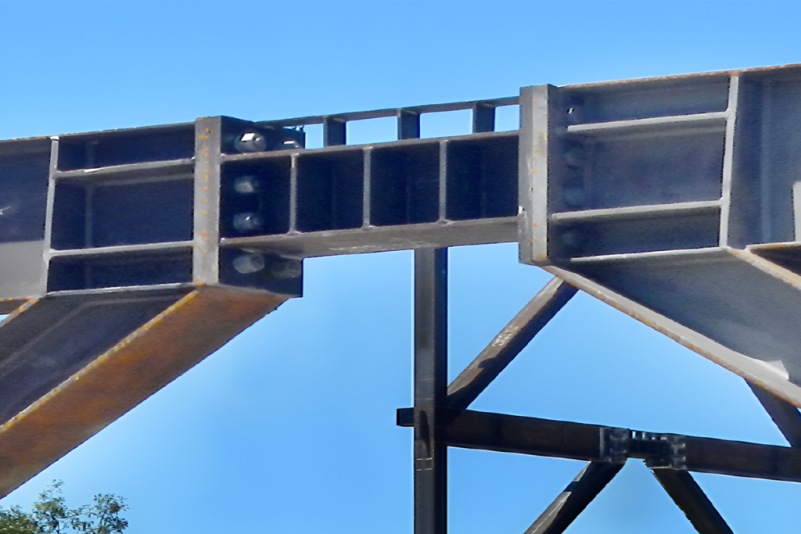What if we could make buildings stronger, greener, and easier to reuse after an earthquake?
This is the rangahau (research) that HERA, in collaboration with our Construction 4.0 research partners, has been exploring by looking at how we can optimise the design of an active shear link to not only reduce the amount of steel used, but also cut carbon emissions to pave the way for a more sustainable future in construction.
A recently published article titled “Structural Optimisation Example for the Design of an Active Shear Link of a Reusable Seismic Frame” [1] explores a real-world case study focused on reusability and optimisation, which is especially relevant in the context of Aotearoa New Zealand’s construction industry and its growing commitment to sustainable, circular practices. The case study demonstrates the design optimisation of an active shear link in Eccentrically Braced Frames (EBF) – a critical structural element that plays a major role in how well a building withstands seismic forces. By refining the strength and design of the shear link, the research has shown we can significantly reduce the amount of steel used. This approach not only improves material efficiency but also minimises the upfront environmental impact and carbon footprint of the project by reducing the total weight of the structure. The environmental benefits are directly proportional to the weight reduction and reusability of the structural elements at the end of life in the same or other building, making this method highly valuable in promoting sustainable practices.
Why material efficiency matters now more than ever!
It’s no secret that the construction industry is one of the largest contributors to carbon emissions and material waste. This is why material efficiency isn’t just a cost saving measure, but an important factor in helping Aotearoa achieve its sustainability targets.
Our research shows that optimising the shear link in an EBF can reduce carbon emissions by 17%, demonstrating the effectiveness of the circular-low carbon strategies developed by HERA, which emphasise avoiding over-specification, and selecting efficient structural systems [2]. It is important to note that the initial analysis results indicate that optimising the entire frame could achieve a 10%–12% reduction in carbon emissions.
Designing with the end in mind
The paper also explores design considerations for connections, such as converting fully welded connections into bolted alternatives, facilitating easier disassembly and reuse. This addresses a major flaw in current construction practices which often sees components of a building become waste once a buildings life cycle is over. A mindset shift towards designing structures for reusability flips this narrative, and is an important step in driving circular construction, reducing waste and extending the lifecycle of materials to minimise environmental impacts. The potential benefits and carbon reduction percentages for different design scenarios are detailed in the research conducted by Andisheh et al [3]. Additionally, the study aligns with one of HERA’s key circular and low-carbon strategies, which emphasises disassembly, reclamation, and reuse of materials in new construction projects [2].
Looking ahead: What this means for the construction sector
The potential of this rangahau to influence change in the industry is immense. As the pressure to build more sustainably grows, so too does the need for innovative solutions that are grounded in both theory and practice. Optimising the design of seismic structures is one such solution, and its ability to reduce material use and lower carbon emissions speaks to the core of what sustainable construction should be about.
This research is a part of HERA’s Endeavour Programme, where we are pioneering the shift to Construction 4.0. By combining state-of-the-art design methodologies with sustainability goals, to contribute to the future of seismic resilience and green construction.
If you’d like to learn more on this research, come join us at our upcoming Construction 4.0 Conference, where industry experts will share insights on cutting-edge innovations like our circular design approaches, low-carbon design strategies, and technological advances in construction and more.
Don’t miss this opportunity to be part of the conversation driving Aotearoa New Zealand’s construction sector forward.
When: 15 November 2024
Where: Fletcher Pavilion, Penrose, Tāmaki Makaurau (Auckland)
Register now: https://www.hera.org.nz/event/construction40conference/
References:
[1] Jármai, K., Hasanali, M., & Andisheh, K. (2024). Structural optimization of a reusable seismic frame active link. CHINA WELDING.
[2] ShahMohammadi, A, Andisheh, K. & Coyle, T (2024). Low carbon circular design guidance for steel, steel-concrete and steel-timber hybrid low-rise commercial buildings, New Zealand Heavy Engineering Research Association (HERA).
[3] Andisheh, K., Maryam, H., Jármai, K., Taheri, H., & Nandor, M. (2024). Evaluating seismic response of innovative reusable eccentric braced frames (EBF). Presented at the 18th World Conference on Earthquake Engineering (WCEE 2024).




